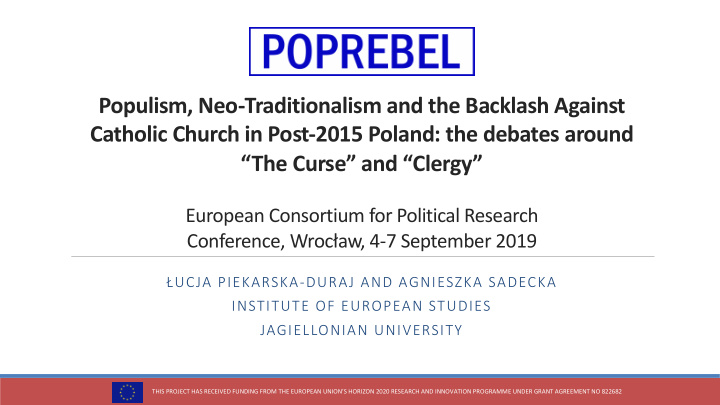



Populism, Neo-Traditionalism and the Backlash Against Catholic Church in Post-2015 Poland: the debates around “The Curse” and “Clergy” European Consortium for Political Research Conference, Wrocław, 4-7 September 2019 ŁUCJA PIEKARSKA-DURAJ AND AGNIESZKA SADECKA INSTITUTE OF EUROPEAN STUDIES JAGIELLONIAN UNIVERSITY THIS PROJECT HAS RECEIVED FUNDING FROM THE EUROPEAN UNION’S HORIZON 2020 RESEARCH AND INNOVATION PROGRAMME UNDER GRANT AGREEMENT NO 822682
“ONLY UNDER THE CROSS, UNDER THIS SIGN ONLY, A POLE WILL BE A POLE AND POLAND WILL BE POLAND” Symbolic images of Catholic Church in Poland Catholic Church as a guardian-shephard Catholic Church as a protector of Polishness Catholic Church as the power aspiring to monopolise the normative order Catholic Church as a political player (strategic alliance with populists at government) How are these images transmitted and contested by culture? Theatre play “The Curse” (2017) directed by Oliver Frlji ć Movie “Clergy” (2018) directed by Wojtek Smarzowski How are these works inscribed in the political context? What is the debate on Catholic Church in times of populism?
The Five Iconic Figures of post- ward Polish Catholic Church • Sacrifice • Victimhood • Tradition • Family
”THE CURSE” Oliver Frlji ć : “Testing of what is allowed in art is my duty”
Mariusz Max Kolonko, Youtuber: “an offensive of “cultural Marxism”” Jan Dziedziczak, PiS: “you think that the Jewish star needs to be protected, while the cross can be spit upon” Pawe ł Lisicki, Do Rzeczy: “I would like to see how these outstanding artists offend other feelings, because so far, their breaking of taboo is only targeted at Catholics”
Maciej Ś wirski, Reduta Dobrego Imienia: such art contributes to the deconstructi on and destruction of the basics of European civilisation
• In right-wing discourses, the Catholic Church is seen as the only group that is attacked • In this way, other groups are denied the status of victims (e.g. minorities) • If Catholics are the only ones to be persecuted, then the demand of a multicultural, diverse society can be questioned. • Catholic Church privileged by the state but threatened by secularisation.
“CLERGY” The Church is holy, but the people in the Church are sinners. Cinematic storytelling vs. social image of clergy as a monolithic class
Metonymy and the logic of victimization: clergy as solid entity Responses of the Church based on Church formats (rosaries, prayers etc.) and not democratic debate
Gazeta Polska “Clergy is our treasure in the fight with Nazism, communism, LGBT and Islamists” Jaros ł aw Kaczy ń ski: “who raises their hand [attacks] on the Church, who wants to destroy it, raises their hand [attacks] on Poland”
CONCLUSIONS Various forms of backlash against the Catholic Church in Poland: Soft backlash among some Catholics: call to face the sins of Church, without denying fundamental Christian values) Decisive backlash among non-believers: various social and artistic independent reactions, aiming to context the dominance of Catholic Church in the public sphere Continuing debate on the Church’s role in Poland by means of different spectacles (theatre play, feature movie, documentary – “Tell No One”) and growing awareness of paedophilia problem among the clergy, resulting in shifting the figure of enemy to LGBT community (the ”real” danger of paedophilia, ”the rainbow pest”) -> backlash to backlash? Populist binary division into good vs. evil (instead of rainbow diversity), Catholic/patriotic vs. Marxist/progressive as a way to define the social world
Recommend
More recommend